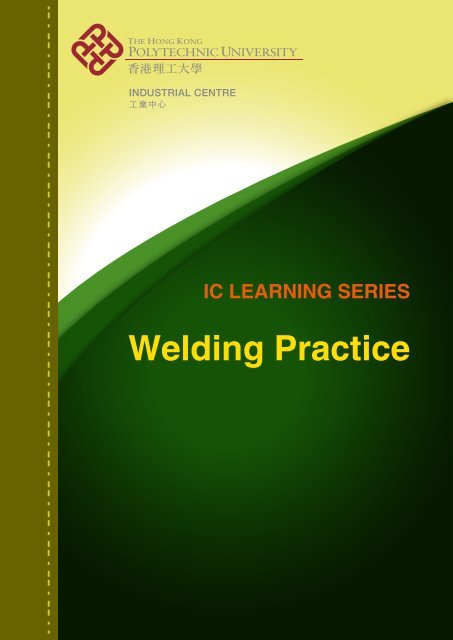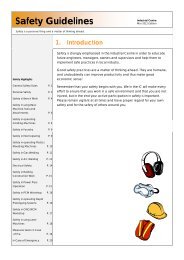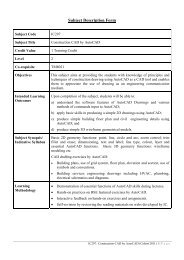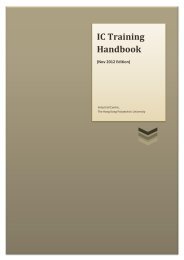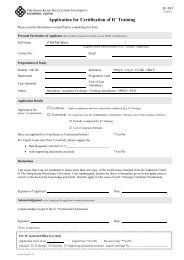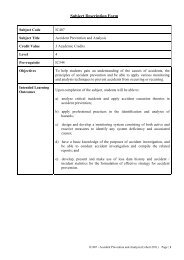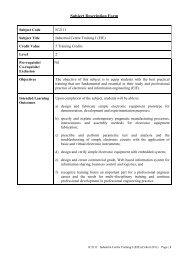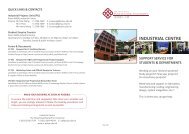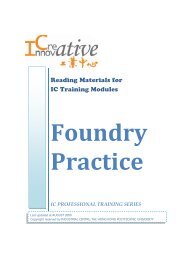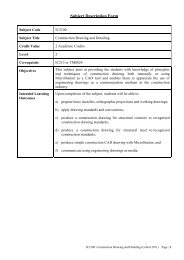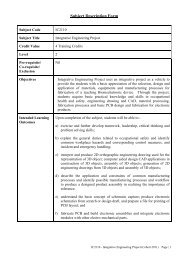Welding Practice - The Hong Kong Polytechnic University
Welding Practice - The Hong Kong Polytechnic University
Welding Practice - The Hong Kong Polytechnic University
You also want an ePaper? Increase the reach of your titles
YUMPU automatically turns print PDFs into web optimized ePapers that Google loves.
IC LEARNING SERIES<br />
<strong>Welding</strong> <strong>Practice</strong>
<strong>The</strong> <strong>Hong</strong> <strong>Kong</strong> <strong>Polytechnic</strong> <strong>University</strong><br />
Industrial Centre<br />
IC LEARNING SERIES<br />
<strong>Welding</strong> <strong>Practice</strong><br />
Suitable for the following learning modules offered by the Industrial Centre:<br />
TM0212 Ducting and <strong>Welding</strong> <strong>Practice</strong><br />
TM0402 Fabrication Processes Appreciation<br />
TM0412 Fabrication and <strong>Welding</strong> <strong>Practice</strong><br />
TM1213 Structural Concrete and Steelwork<br />
IC2113 IC Training I (TSE)<br />
IC235 Integrated Practical Training<br />
IC253 Introduction to Product Prototyping and Fabrication Processes<br />
IC348 Appreciation of Manufacturing Processes<br />
Last updated: June 2012<br />
Copyright reserved by Industrial Centre, <strong>The</strong> <strong>Hong</strong> <strong>Kong</strong> <strong>Polytechnic</strong> <strong>University</strong>
<strong>Welding</strong> <strong>Practice</strong><br />
<strong>Welding</strong> <strong>Practice</strong><br />
Objectives:<br />
<br />
<br />
To understand the basic principles of common welding technologies<br />
To be able to select and apply among different kinds of weld.<br />
1. Introduction<br />
<strong>Welding</strong> is a permanent joining of two materials, mainly metals, through<br />
localized coalescence, resulting from a suitable combination of temperature,<br />
pressure, and metallurgical conditions. In the last fifty years, welding technology<br />
has been developed extensively and it is now the case that its use may often<br />
result in the saving of time and money when compared with some other<br />
methods of manufacturing. Today, welding is used in a wide range of<br />
applications, both in jobbing production (one off) as well as in the mass<br />
production industries. Typical applications are found in shipbuilding, the aircraft<br />
industry, civil engineering and construction, automobile manufacturing, and<br />
many consumer product manufacturing industries. With the advancement of<br />
automatic welding techniques and equipment, welding is no longer a skill-ofhand-dependent<br />
activity nor is it necessarily a costly process. Nowadays, welding<br />
equipment is often highly automated, including the increasing use of industrial<br />
robots leading to good system flexibility as to use coupled to a high degree of<br />
accuracy and quality. Developments of this kind allow welding now to be used<br />
for work with high precision requirements previously considered impossible and<br />
uneconomical.<br />
1.1 FUNDAMENTAL PRINCIPLES OF WELDING<br />
A weld is defined as a localized coalescence of metals wherein coalescence is<br />
produced by heating the metal to suitable temperatures, with or without the<br />
application of pressure and with or without the use of any filler metal.<br />
Page 1<br />
IC Professional Training
<strong>Welding</strong> <strong>Practice</strong><br />
Details of a Weld<br />
In order to obtain coalescence between two metals, there must be a combination<br />
of proximity of surfaces and sufficient activity between the molecules of the<br />
pieces being joined to cause the formation of common metallic crystals. Such<br />
proximity and activity are often impeded by an oxide layer or a thin layer of<br />
absorbed gas on the oxide surface. <strong>The</strong>se contaminant layers must be removed<br />
by mechanical or chemical means in order to obtain satisfactory welds.<br />
In summary, in order to obtain satisfactory welds it is necessary to have a<br />
satisfactory heat and/or pressure source, a means of protecting or cleaning the<br />
metal, and avoidance of, or compensation for, harmful metallurgical effects.<br />
2. <strong>Welding</strong> Processes<br />
<strong>The</strong> field of welding can be divided into two main classifications fusion and nonfusion.<br />
Fusion welds are usually made without the assistance of mechanical<br />
pressure. Non- fusion welds generally necessitate the assistance of mechanical<br />
pressure to bring the heated surfaces into intimate contact.<br />
When parts are joined by fusion the method is very similar to a casting process<br />
since the surfaces being welded are heated until they melt and run together. If a<br />
filler is added this is melted along with the metals being joined and run into the<br />
space which it is necessary to fill.<br />
2.1 Gas <strong>Welding</strong><br />
Gas welding comprises the group of welding processes in which the heat<br />
necessary for welding is obtained from the combustion of a fuel gas oxygen<br />
Page 2<br />
IC Professional Training
<strong>Welding</strong> <strong>Practice</strong><br />
mixture. <strong>The</strong> fuel gases which may be used include acetylene, butane, coke gas.<br />
ethylene hydrogen, natural gas, propane, and other petroleum derivatives or<br />
mixtures. Because acetylene in combination with oxygen produces the hottest<br />
flame, oxy-acetylene welding is the most commonly used of these processes. <strong>The</strong><br />
equipment required for gas welding is simple and compact, making it especially<br />
useful for maintenance or site work where portability is an advantage. However<br />
the rate of welding is slower with gas than with arc welding and the lower heat of<br />
gas welding limits its use. For production purposes, it is ideally suited to lightgauge<br />
metals work, as in aircraft and automotive assemblies of sheet and tube,<br />
or to the welding of metals which have low melting points, such as copper and<br />
its alloys.<br />
2.1 Arc <strong>Welding</strong><br />
Arc welding is a fusion process in which the welding rod is cast into the<br />
previously fused space between the metals to be joined. <strong>The</strong> heat necessary to<br />
melt the metal and welding rod is obtained from an electric arc struck between<br />
the rod (electrode) and the work, a temperature of 3500-4000°C being obtained<br />
near the crater (Fig 3) of the arc.<br />
<strong>The</strong>re are many types of arc welding processes, some of the common ones<br />
are outlined below.<br />
Page 3<br />
IC Professional Training
<strong>Welding</strong> <strong>Practice</strong><br />
Shielded metal-arc welding is probably the most widely used welding process.<br />
For the most part, welding with this process is done manually. It may be used in<br />
all positions: flat, vertical, horizontal, and overhead. Suitable electrodes are<br />
available for shielded metal-arc welding of plain carbon steel, low-alloy steel,<br />
stainless steel, copper 'and its alloys, aluminium and its alloys, and cast iron. A<br />
diagram of shielded metal-arc welding is as shown in Fig 3. Submerged-arc<br />
welding can be used in a fully automatic system set-up with the electrode and<br />
granular flux (see Fig 4) feed-controlled and either the welding head traversing<br />
the work or the work moving under a fixed head. Because it is necessary that the<br />
flux remains on the joint, this welding method is restricted to the flat position<br />
except for horizontal fillet welds.<br />
Inert gas arc welding employs either consumable electrodes (see Fig 5) or nonconsumable<br />
electrodes, (see Fig 6) with the arc drawn between the electrode and<br />
the work piece. Inert gas such as carbon dioxide, helium, or argon is used to<br />
provide shielding of the arc and the molten metal. Consumable electrode inert<br />
gas arc welding is commonly referred to as Metal-arc Inert Gas welding (MIG)<br />
whilst non-consumable electrode inert gas arc welding is referred to as Iungstenarc<br />
Inert Gas welding (TIG) because tungsten electrodes are used in the process.<br />
In the case of TIG filler metal, where needed, is provided by a welding rod<br />
inserted into the arc without forming a part of the welding circuit.<br />
Page 4<br />
IC Professional Training
<strong>Welding</strong> <strong>Practice</strong><br />
Inert gas arc welding was originally developed for welding light metals,<br />
aluminium and magnesium. Its use has been extended to the welding of stainless<br />
steels, mild steels, copper and nickel and their alloys, and the more recent high<br />
temperature metals such as titanium and zirconium.<br />
2.1 Brazing<br />
<strong>The</strong> brazing process differs from welding processes in that the non ferrous filler<br />
metal used has a melting point below that of the metal to be brazed, but higher<br />
than 450°C, and further, the flow of filler metal through the joint is by capillary<br />
attraction. To accomplish this action, the joint should have a clearance of 0.05 to<br />
about 0.25 mm depending upon the shape of the joint.<br />
Page 5<br />
IC Professional Training
<strong>Welding</strong> <strong>Practice</strong><br />
Brazing and Braze <strong>Welding</strong><br />
Joint preparation for brazing<br />
Brazing is mainly employed for sheet steel and tubular work, for bronze<br />
surfacing, and for joining dissimilar metals. <strong>The</strong> main advantage of the process is<br />
that the joint surfaces are heated only to the melting point of the welding rod,<br />
which is several hundred degrees lower than that of the iron or steel.<br />
3. Special <strong>Welding</strong> Processes - Cutting Operations<br />
Cutting process is a method which brings removal of metals. This can be done by<br />
machining, melting and chemical reaction, nowadays oxygen acetylene flame<br />
cutting and plasma arc cutting metals process are widely used in industry fields.<br />
<strong>The</strong> two cutting methods may be done by manual or with mechanized<br />
equipment. In manual cutting process, the operator manipulates a cutting torch<br />
over the area to be cut. In machine cutting process, the torch is guided entirely<br />
by automatic controls.<br />
3.1 Oxy-acetylene Flame Cutting<br />
Cutting metal by oxy-acetylene process is done by means of hand cutting torch<br />
or by more complicated, automatically controlled cutting machine. (Fig 10 and<br />
11). When a piece of ferrous metal is heated by hot flame until red-hot and then<br />
exposed to pure oxygen, a chemical reaction takes place between the heated<br />
metal and the oxygen. This reaction causes rapid burning and oxidation of the<br />
Page 6<br />
IC Professional Training
<strong>Welding</strong> <strong>Practice</strong><br />
metal. By this continuous process of oxidation, the metal can be cut through very<br />
rapidly.<br />
3.2 Plasma Arc Cutting<br />
Plasma arc cutting can be used for cutting all electrically conductive materials,<br />
including stainless steel and aluminium. In this process, when an arc is struck<br />
between the electrode in the torch and the workpiece, gas is heated to a high<br />
temperature, and change into positive ions, neutral atoms and negative<br />
electrons. When matter passes from one state to another, latest heat is<br />
generated and for. a high velocity plasma gas jet, which can melt the metal and<br />
blow it away to form a kerfs <strong>The</strong> basic arrangement and terminology for a<br />
plasma arc torch are shown below. (see Fig 11)<br />
4. Quality Control and Testing of Welds<br />
Two main methods are employed in the quality control and testing of welds,<br />
namely, destructive testing and non-destructive testing. <strong>The</strong> former method is<br />
mainly used in a mass production situation where it is acceptable to lose a few<br />
pieces of a workpiece from a large batch so as to obtain sufficient information<br />
concerning the quality of the welds. Non-destructive testing, however, is aimed<br />
at checking the quality without causing any damage to the workpiece, and this is<br />
often employed on work such as in shipbuilding and civil engineering steel<br />
structures.<br />
Destructive testing is essentially in determining the mechanical properties of the<br />
weld. Non-destructive testing is for spotting internal defects that impair the<br />
soundness of the weld during production. <strong>The</strong> degree of acceptance of quality<br />
thus has to be carefully worked out.<br />
Page 7<br />
IC Professional Training
<strong>Welding</strong> <strong>Practice</strong><br />
4.1 Weld Defects<br />
Several types of weld defects are commonly found in practice. <strong>The</strong>y are porosity,<br />
burn-through blow-holes, slag inclusions, poor penetration, undercuts, and<br />
cracks. Fig 12 illustrates these defects.<br />
Page 8<br />
IC Professional Training
<strong>Welding</strong> <strong>Practice</strong><br />
4.2 Non-destructive Testing Methods<br />
<strong>The</strong> Magnetic Particle method is used for detecting flaws and cracks in<br />
paramagnetic materials, principally iron and steel. <strong>The</strong> principle of the method<br />
involves magnetizing ferromagnetic parts in such a direction that the magnetic<br />
flux will produce north and south poles at opposite edges of a discontinuity, then<br />
applying finely divided magnetic particles to the vicinity. <strong>The</strong> particles are<br />
attracted and held by the 'leakage' fields between poles. <strong>The</strong> readily visible<br />
accumulation of these particles indicates and outlines the discontinuity.<br />
4.2.1 Dye penetration<br />
<strong>The</strong> Dye penetration method provides a means of detecting discontinuities which<br />
are open to the surface. Penetrants are applied to the surface and are drawn into<br />
the discontinuities by capillary action. <strong>The</strong> excess penetrant is removed and. a<br />
developer is applied to the surface. <strong>The</strong> penetrant remaining in the<br />
discontinuities will be drawn back by blotting action of the developer and will<br />
colour or stain the developer to form a visible indication from which one can<br />
interpret the characteristics of the discontinuity.<br />
Page 9<br />
IC Professional Training
<strong>Welding</strong> <strong>Practice</strong><br />
4.2.2 Ultrasonic testing<br />
Ultrasonic testing utilizes mechanical vibration in detecting imperfections in<br />
materials. At very high frequencies such as 1 to 10 megacycles, mechanical<br />
vibration can be generated in the form of well defined beams of small cross<br />
section. <strong>The</strong>se beams can be directed into work pieces on internal examination<br />
somewhat in the manner of X rays. Like other wave motions, the beams are<br />
subject to the laws of reflection and refraction when they encounter changes in<br />
the physical properties governing the propagation of vibrational waves. Thus any<br />
unhomogeneity can be detected as this represents a substantial change in either<br />
the elastic modulus or the density of the material. In practice, commercial<br />
instruments do not measure these parameters directly; instead they indicate one<br />
or more-of the factors involved in sound-wave propagation; velocity of travel,<br />
attenuation of beam, and reflection of energy from discontinuities.<br />
4.2.3 Radiographic<br />
Radiographic method of inspection utilizes the shadow pattern resulting from<br />
penetrating radiation to determine a material's homogeneity. This inspection<br />
process requires a source of penetrating radiation such as radioisotopes or X-ray<br />
generators, and recording devices such as film or fluoroscopic screens.<br />
Inspection is accomplished by registration of discontinuities in the material on<br />
the observing medium, and relating them to the material's physical properties.<br />
Page 10<br />
IC Professional Training
<strong>Welding</strong> <strong>Practice</strong><br />
References<br />
<strong>The</strong> Procedure Handbook of Arc <strong>Welding</strong>, <strong>The</strong> Lincoln Electric Company.<br />
ASM Handbook Volume 6, 6A<br />
American <strong>Welding</strong> Society<br />
Last Updated: Jun 2012<br />
Page 11<br />
IC Professional Training


